Breakthrough Starshot’s four-meter sails are the latest (and best funded) concept in a long series of beamed propulsion ideas. As Jim Benford explains below, the idea of beaming to a sail goes back over fifty years, with numerous papers and the beginnings of laboratory work in the intervening decades. What follows is the first cut at a timeline of this work, one that Jim intends to supplement and re-publish here with full references. Keeping in mind the scope of the timeline as Jim explains it, feel free to suggest any missing references in the comments. Discover Magazine, by the way, has just published a look at the Benfords’ work on beamed sails called “Riding on a Beam of Light,” now available for subscribers online.
by James Benford
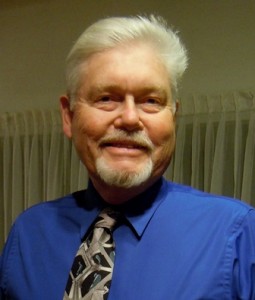
From recent media pieces following the announcement of Breakthrough: Starshot, I gather that the press is not aware of how much has been done by the propulsion community over the last decades in the areas of photon beam-driven sail system concepts, to include experiments and simulations of sail beam-driven flight, sail stability (‘beam-riding’), and dynamics (such as beam-driven spin of sails for stability).
This is a brief history of the deep origins, significant events in the development of beam-driven sails for interstellar travel purposes. It excludes, for example, solar sails, launch to orbit, and mass beams. For those interested in mass beams, my thoughts on the subject, with references, appear in several earlier articles here [see, for example, Sails Driven by Diverging Neutral Particle Beams] as well as in a JBIS review article by Nordley and Crowl (“Mass Beam Propulsion, An Overview”, JBIS 68, pgs. 153-166, 2015).
First mention of beam-driven propulsion for interstellar purposes in the refereed literature was by Bob Forward, in Missiles and Rockets in 1962. More people perhaps read the Marx paper in Nature four years later, but Marx didn’t pursue his idea further, at least not in the literature.
But Bob did continue to work on it and built the foundations of the subject. This is described in his unfinished autobiography, Fast Forward Fifty Years.
My thoughts on the timeline of significant events, meaning ideas and actions that advanced the field and influenced following events, including recent milestones, follow below.
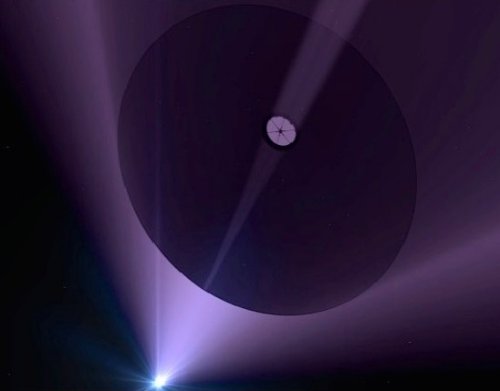
Image: Beamed propulsion leaves propellant behind, a key advantage. Coupled with very small probes, it could provide a path for flyby missions to the nearest stars. Credit: Adrian Mann.
The Visionary Era

- 1962: First mention of beam-driven propulsion for interstellar purposes in the refereed literature, by Robert L. Forward, in “Pluto – Gateway to the Stars,” in Missiles and Rockets.
- 1966: G. Marx publishes the concept for Interstellar Vehicle Propelled by Laser Beam’ in Nature. He considered only x-rays to drive the sail, because he flinched from large apertures for the antenna and sail.
- 1967: Robert Forward and Eugene Mallove publish the first Interstellar Bibliography.
Image: Interstellar propulsion theorist Robert Forward.
- 1974: Authors Larry Niven and Jerry Pournelle feature an interstellar laser-pushed lightsail in their science fiction novel The Mote in God’s Eye, basing their design on unpublished calculations by Robert Forward.
- 1975: Richard Dickinson and Robert Brown demonstrate efficient transmission of 34 kW over 1.5 km.
- 1976: Robert Forward proposes a roadmap for interstellar exploration with a launch to Alpha Centauri in 1995.
- 1980: Bruce Murray, director of JPL, convenes a workshop to make a concept for an interstellar probe. Members include Freeman Dyson, Robert Forward, Robert Bussard, William Fowler and Robert Leighton. Dyson and Forward quantify Forward’s 1962 concept, including a means of returning a payload. Murray is disappointed by the large size of the sail and beamer, as well as the enormous power required. The Workshop papers are never published. Forward continues work on his concept.
- 1982: Robert Forward proposes laser-driven return star missions in his science fiction novel Flight of the Dragonfly. The final expanded version, Rocheworld, with technical appendix, appears in 1990.
- 1984: Forward presents “Roundtrip Interstellar Travel Using Laser-Pushed Sails,” the first detailed analysis showing the feasibility of the lightsail concept.
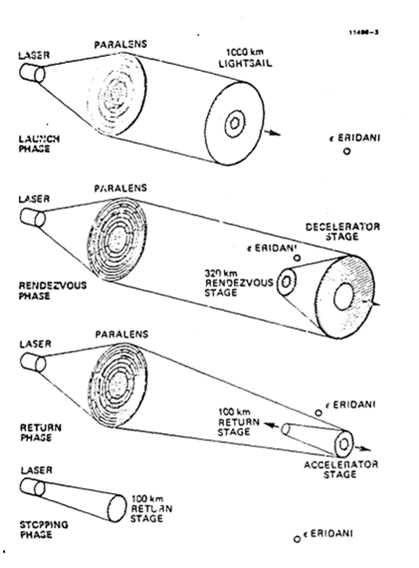
Image: Forward’s separable sail concept used for deceleration, from his paper “Roundtrip Interstellar Travel Using Laser-Pushed Lightsails,” Journal of Spacecraft and Rockets 21 (1984), pp. 187-195. The ‘paralens’ in the image is a huge Fresnel lens made of concentric rings of lightweight, transparent material, with free space between the rings and spars to hold the vast structure together, all of this located between the orbits of Saturn and Uranus.
- 1985: Forward, encouraged by conversation with Freeman Dyson, proposes microwave beam-driven interstellar flybys in “Starwisp: An Ultra-Light Interstellar Probe.” He also introduces the ‘smart sail’ concept whereby the sail contains microcircuits which capture images and diagnostic data, returns data to Earth.
- 1986: Forward conducts first study of dielectric film sails.
- 1989: Geoffrey Landis analyzes the laser driven lightsail, concluding that the performance is driven by the temperature limits of the sail, and proposes refractory dielectric films as sail material.
First Steps
- 1999: NASA Advanced Concepts Office, largely driven by JPL, proposes a roadmap for interstellar exploration with a launch to Alpha Centauri in 2028. Limited funding of initial studies and experiments follow.
Image: Plan for the development of sails for interstellar flight, 1999.
- 1999: Tim Knowles of ELSI invents the carbon micro-truss, a strong, very low areal mass density graphite sheet that doesn’t melt; it sublimes at very high temperature.
- 1999: Geoffrey Landis and James Benford propose using the new carbon micro-truss, strong structures of very low mass per square meter. They show that, with this material, a laboratory experiment can demonstrate microwave beam-powered sailing.
- December 20, 1999: Leik Myrabo-led team measures deflection of a pendulum moved by laser beam hitting sails of carbon micro-truss, giving acceleration of 0.15 gravities.
- Feb 2000: Geoff Landis reexamines use of dielectric films for highly reflective sails, points out drawbacks to multiple layers.
- March 2000: Gurkirpal Singh of JPL, in a dynamics simulation, shows that conical sails can ride a beam stably.
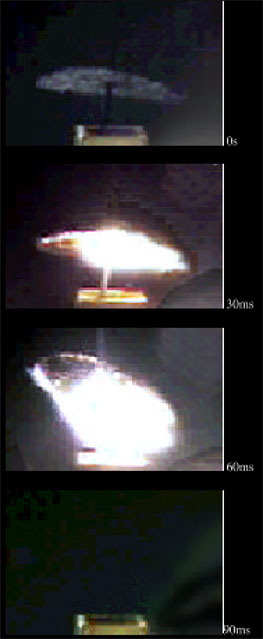
- April 5, 2000: James Benford-led team achieves first flight, at JPL. Sails of carbon micro-truss, driven by microwave beam, are accelerated up to 13 gravities; sails are recovered intact. They discover the highest accelerations are due to desorption of deeply embedded chemicals when the sail reaches high temperatures. Experiments are described in “Microwave Beam-Driven Sail Flight Experiments.”
- June 12, 2000: James Benford-led team spins a suspended micro-truss sail with circularly polarized microwave beam. Basic physics of spin-driven effects are demonstrated.
- December 8, 2000: Leik Myrabo team, using a carbon-dioxide laser, flies molyebdenum-coated carbon sails at 1 gravity above liftoff, giving velocities up to 3 m/sec.
Image: First flight of beam-driven sail. Carbon sail lifts off truncated rectangular waveguide under 10 kW microwave power. (4 frames, 30 ms interval, 1st at top).
- July 2000: Geoff Landis, in “Starwisp Revisited,” substantially reduces mass and power required for microwave-driven mesh sail.
- 2002: Stable beam-riding of a conical sail on a microwave beam demonstrated experimentally by the Benford brothers, Gregory and James, at UC Irvine. Physics of spin-driven effects on various sail shapes are explored in both experiment and theory.
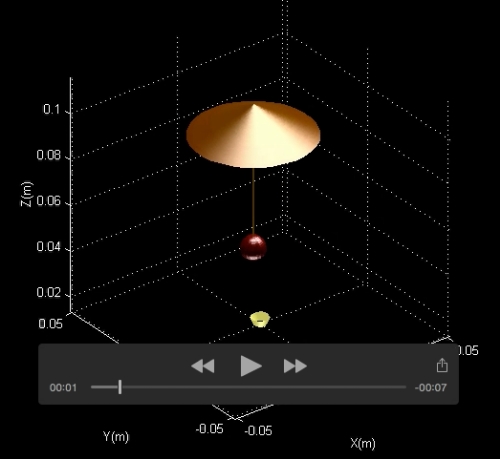
Image: Geometry of 3-D sail simulation used to access sail stability. Beam is injected from horn at bottom.
- 2003: Chaouki Abdallah and team at UNM, with a 3D dynamics simulation, confirm that the conical (umbrella) sail is the most passively stable shape, while other shapes, such as inverse conical, are not stable. They quantify the stable parameter range for beam shape, angle of the cone and location and mass ratio if sail and payload. They show that active dynamic feedback control can stabilize most shapes.
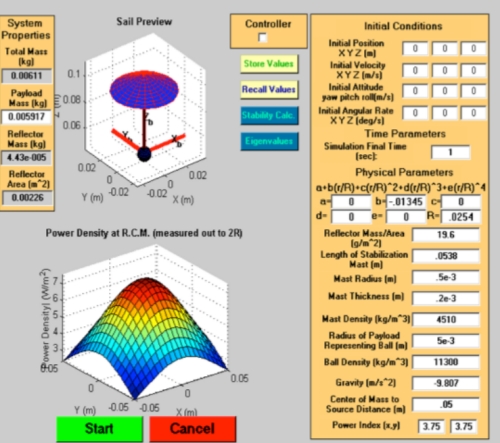
Image: Graphic user interface for sail stability simulation, Chaouki Abdallah 2003. Geometry
of sail shown above, power distribution of beam shown below.
Becoming Real
- May 21, 2010: First deployment of a functional solar sail in space, “IKAROS” (Interplanetary Kite-craft Accelerated by Radiation Of the Sun) is demonstrated by the Japanese Space Agency JAXA.
- 2011: “100 Year Starship”, a joint project between NASA (Pete Worden) and DARPA (David Neyland), convenes a colloquium in Orlando to discuss interstellar travel, stimulating interest in practical starflight.
- 2012: Greg Matloff proposes graphene for sail material that can sustain high accelerations.
- 2013: Starship Century Symposium held at UC San Diego May 20, date of the publication of the book Starship Century. A second Starship Century Symposium is held at the Royal Astronomical Society in London. In the book James Benford predicts “the first starship will be a sail – a sailship – driven by a beam of photons.”
- 2013: James Benford creates a cost-optimization equation for beam-driven propulsion systems.
- April 2015: Philip Lubin introduces concept for small ultra-light ‘spacecraft on a wafer’ using multi-layer dielectric on metalized plastic film. In “A Roadmap to Interstellar Flight,” Lubin draws on Forward’s laser-sail work and extends it into much smaller sail designs.
- August 2013: 1st Interstellar Congress held in Dallas, Texas by Icarus Interstellar. Eric Malroy introduces concepts for the use of nanomaterials in sails.
- March 2016: Yuri Milner concludes the only credible way to achieve interstellar travel in the near-term is beam-driven sails, in consultation with Avi Loeb, Pete Worden and Pete Klupar.
- April 12, 2016: Yuri Milner, Stephen Hawking and Pete Worden announce the beginning of Breakthrough Starshot, a project to launch beam-driven sails to Alpha Centauri within 20 years. Freeman Dyson is present.
- 2016: Kevin Parkin creates an engineering inference engine for optimizing beamed sail systems, including cost minimization.
- April 15, 2016: Breakthrough: Discuss, a 2 day symposium, brings together the Breakthrough Starshot team, as well as that of Breakthrough: Listen, a SETI project begun it 2015.
The notional timeline for Starshot is said to be 10 years of R&D, 10 years for construction of the System, 21 years transit time for the first sailcraft. At 0.2 c, it would enter the Alpha Centauri double-star system in 2057, a century after the first Earth satellite.
“Make no mistake — interstellar travel will always be difficult and expensive, but it can no longer be considered impossible.”
-Robert Forward, 1985
We owe it to the future to record our past. What I have described is journalism, but journalism is only the first draft of history. Doubtless there are significant events I have forgotten or never knew. Please suggest additions and modifications. A revised timeline will appear later, including references.
I thank those who I interviewed over the years about history: Robert Forward, Freeman Dyson, Geoff Landis, Kevin Parkin, Gregory Benford, Leik Myrabo, Pete Klupar, Avi Loeb and Gregory Matloff.

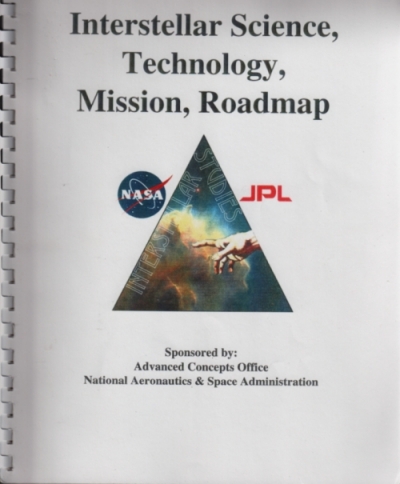


Perhaps you could include a link to Dr. Lubin’s vision. http://www.deepspace.ucsb.edu/wp-content/uploads/2015/04/A-Roadmap-to-Interstellar-Flight-15-d.pdf
Ahh sorry. Here’s the most recent revision. https://arxiv.org/ftp/arxiv/papers/1604/1604.01356.pdf
Thanks John, nice find
Cool to see this as a timeline. That helps remind us that it takes a legacy of events to add up to progress.
I believe stabilisation could be controlled via using electric fields to control the transparency of the dielectric mirror, very, very small time controls can be achieved. The spinning could be controlled via a grating texture that deflects some light to the side. The electronics and MEM’s can be protected against heating via added layers of dielectric to improve reflection in those regions.
We have the technology now to build at least scale models, it is no longer a miracle^X project.
Perhaps we don’t need to spin the sail too much if we had a diffraction grating surface structure that reflected some of the the light towards the centre of the sail to tension the sail.
https://www.rp-photonics.com/diffraction_gratings.html
As for the control of the reflectivity of the dielectric the change can be very rapid, sub femto seconds~ 10^-15!
You’d have to have fine control; The sail in the Starshot concept is undergoing enormous acceleration, and yet is incredibly flimsy; At that level of acceleration, each tiny part of the sail is going to have to be in effect flying independently in formation with the rest of the sail, because the inherent structural strength of the sail material is so tiny compared to the forces involved. A momentary fraction of a percent force imbalance would tear the sail to pieces.
Glass and diamond potential materials are very strong in tension and even stronger in compression. If they are very thin they can be very flexible.
https://www.technologyreview.com/s/600894/flexible-glass-could-bring-back-the-flip-phone/
Femto second control allows micron control movements.
At one point there was a critique of Lubin’s use of lasers for sail propulsion compared to microwaves. Has this changed in the light of new developments, and if so, what were those developments?
The critique was from Jim Benford, purely on costing grounds. I don’t believe much has changed, but the advantages of lasers may lead to their cost coming down with further R&D.
He assumes the acceleration is constant because the beam power is constant. That depends on the instantaneous power required for the probe each instant and if the beam can deliver that power at higher speeds.
The beam power can’t be constant to keep the sails acceleration constant because of the Doppler effect, but been a phased array that will not be a problem.
The instantaneous power of the beam has to be able to provide the power to maintain the constant acceleration. This becomes increasingly difficult as the speed increases since the beam can only add energy at a fixed rate in time yet the kinetic energy increases quadratically. At some point, there is a mismatch. That makes the concept of a constant acceleration engine hard to realize.
This may all be worked out here since the acceleration phase is short.
With the phased array the frequency of some of the lasers can have a higher frequency to componsate for the doppler effect provided they don’t have atmospheric issues, the frequency shift is not that big but it will affect the power delivered.
What I said sounds right but now I think it’s wrong. Only the power in the instantaneous rest frame of the ship matters. The increasing velocity of the ship is not relevant in that frame of reference. The Doppler effect is small except at very relativistic speeds wrt the beam.
One question I never see asked about Starshot:
How will any data make it back to Earth, with a small sail and tiny payload?
Colin, one of the reasons for the multiple papers on gravitational lensing at the recent Breakthrough: Starshot event was to consider whether it would allow data return from such tiny payloads. Getting data back at any reasonable rate at these distances is a huge problem, and is one of the many challenges Starshot has identified as possible deal-breakers unless it can be solved.
Colin, there is also the possibility of using relay sails, if they are very cheap many can be made. If many can be made and sent on as a stream of probes they can not only be used for relaying information to and fro but also used to observe space around them, much would be seen with thousands of probes.
Colin:
The answer to your question can be found on pages 6-7 here:
http://www.deepspace.ucsb.edu/wp-content/uploads/2015/11/Brashears-etal-SPIE-2015-Interstellar-WaferSats-v07b-comments-removed.pdf
Thanks for that Andrew. It does look just possibile, which can only be improved on.
Alex & Adam: I didn’t make a critique of Philip Lubin’s preference for lasers compared to microwaves. My argument about their relative costs, both capital and operating costs, was published 3 years ago in a paper “Starship Sails Propelled By Cost–Optimized Directed Energy” in JBIS. There I proposed a figure of merit proportional to the capital (equipment) cost of a directed energy system. For a given mission, the minimized cost scales like [p^2/3a^2/3]/f^2, where p is the cost of beam power per watt ($/W), a is the cost per square meter of the radiating aperture and f is the frequency. I found that the microwave, millimeter-wave and laser technologies had equivalent costs, I e., the same figure of merit.
The focusing advantage of lasers, which is the essence of Lubin’s argument, is canceled by the high cost of both laser equipment and laser apertures. In addition, the operating cost, the cost of electricity to produce the beam, is much higher for lasers because of their low efficiency. So they have a higher total cost when you count both the cost of building the system and the cost of operating it. It appears that today the total cost of millimeter-wave systems is lower than either microwave or laser systems.
Lubin counts on “Moore’s Law” (the observation that the number of transistors in a dense integrated circuit doubles approximately every two years) to make lasers much cheaper in the future, but there’s very little cost data about fiber lasers so far because of their rather recent development.
I think the argument about one frequency over another is a diversion. The important questions are:
1) How do we make a sail that can sustain high acceleration? Of course, the material chosen for the sail must be able to reflect the beam very well and absorb practically nothing in order to be practical at high accelerations and that choice of materials is frequency dependent.
2) How do we make the sail ride on the beam in the stable passive way? The latter question does not depend upon frequency, only on the beam shape, sail shape, reflectivity and mass distribution. Therefore useful experiments can be done with millimeter and microwave systems, which are much more readily available and much cheaper to operate compared to lasers.
‘How do we make the sail ride on the beam in the stable passive way?’
We may have to have a compromise, a semi-stable conical shape with control surfaces and/or reflectances changing devices around the skirt of the craft. MEM’s can be used to adjust the surface of the skirt to control the amount of light and therefore forces applied, the same can be said for using electric fields to adjust the dielectric reflectivity of the mirror around the edges. The internal cavity of the sail can be used to house a MEM’s gyroscope to keep it on target and allow active control, they can be very accurate and very small and survive high G forces.
I believe thePlanetary Society has a solar sail initiative underway: http://www.planetary.org/blogs/jason-davis/2016/20160609-lightsail-2-morse-code.html.
Dear Paul and Jim
Very nice timeline. Just one small correction–you might wish to add that Bob Forward’s 1985 paper on Starwisp was encouraged by conversation with Freeman Dyson.
Regards, Greg
The author proposes laser arrays 10km on a side. That’s just a non starter for me. How can such concepts be taken as serious?
Been a phased array each laser built can still carry out tasks in the solar system, it can be made to pay for itself more and more.
Robert, if you’re referring to the Breakthrough Starshot phased array, the initial thinking is 1km to the side not 10.
Thanks, I was confusing that with Dr. Lubin’s vision.
I realize that Lubin’s original photonic drive cannot work unless the the vehicle had active control to stay on the beam, as the mirror would need to be conic for stability and therefore unable to reflect the beam between source and vehicle.
As for small scale experiments, an evacuated volume on the ISS would be an interesting test bench. Is there any way to do that – provide an enclosed volume inside a module, which can be evacuated to space outside for such experiments?
‘I realize that Lubin’s original photonic drive cannot work unless the the vehicle had active control to stay on the beam, as the mirror would need to be conic for stability and therefore unable to reflect the beam between source and vehicle.’
A conical sail can be made with the surface designed in steps to reflect the laser light.
A vertical evacuated tube a few inches in diameter could be used, might be a lot cheaper than going into space.
I don’t understand the dynamics of a conical sail, but I think your stepped idea won’t work. As the sail drifts out of alignment, I think it is the horizontal vector of the reflected beam that pushes the sail back on station. For a stepped system to work, at least part or the beam would have to be reflected with a horizontal vector.
What happens when the sail points away from the beam direction? That is one scenario I don’t understand teh dynamics of. Intuitively a reverse conic should work, but it is stated that it doesn’t compared to a forward conic. For a photonic propulsion, the sail must remain perfectly oriented to reflect the beam back to its source. A stepped mirror won’t work if the sail wobbles away from its correct orientation.
For a large sail and craft, small thrusters could work to keep the sail oriented correctly, but this wouldn’t work for tiny sails.
‘What happens when the sail points away from the beam direction? That is one scenario I don’t understand teh dynamics of. Intuitively a reverse conic should work, but it is stated that it doesn’t compared to a forward conic. For a photonic propulsion, the sail must remain perfectly oriented to reflect the beam back to its source. A stepped mirror won’t work if the sail wobbles away from its correct orientation.’
In the conical sail I see as the sail goes off centre less light is available at the side that moves towards the centre line away from the beam, the other side gets more light as it moves into the beam and therefore is pushed back into line. A reverse conical sail does not have the centre of mass advantage of a normal conical sail and is therefore less stable in the beam.
‘For a large sail and craft, small thrusters could work to keep the sail oriented correctly, but this wouldn’t work for tiny sails.’
There are tehnologies for small satellites that could be built for sails.
http://lmts.epfl.ch/MEMS-ion-source
But what you haven’t answered is what happens when the sail points in a different direction to the beam, so that the reflection does not return to the source? If the “steps” are cubic reflector, the beam reflects correctly but doesn’t correct the sail attitude to the beam. I think you only get to pick one.
There is going to be some to the sides but only a small amount of energy is needed to correct the attitude of the craft. Perhaps cubic reflection at the centre regions with normal reflectance to the sides at the top where there is more leverage to move the sail.
This is starting to feel like a classic cybernetics problem. How to design a sail with varying properties to maximize stability with a true photonic drive. That I would like to see in simulations, and if manufacturable, a small test in a vacuum.
It won’t be exactly like balancing a pin on a fired artillery shell but it must get really close to it! We could test low powered versions fairly easily, if we could balance a sail actively on a laser beam we would have made enormous progress.
For manned missions going beyond 1000 km per second, the wafer chips could be accelerated at a manned ship with a pusher plate (like the Project Orion ship) but the energy would be kinetic and not nuclear.
For large object construction, we need to develop the Tether Unlimited Spiderfab.
A further reference for the timeline.
Author Larry Niven has aliens called Monks arrive On Earth in his novelette “The Fourth Profession” (1971). Their ship was sent here by laser beam. The Monks want humans to build a giant laser cannon to launch their starship and accelerate it to a large fraction of lightspeed sending them on their way for the next leg of their interstellar journey.